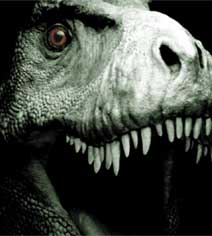
|
||||||
|
|
||||||
|
|
|
Study of Sue reveals extensive injuries
Rega and Brochu found evidence of numerous injuries that had healed before the giant carnivore died. Fractures of the right and left ribs indicate Sue recovered from two traumatic blows to the body. Studies of arm and leg bones showed they had healed from infections. Both sides of the jaw also showed lesions common in other large tyrannosaurs. And bony growths on vertebrae indicated back problems.
Yet the dinosaur may have reached old age, says Rega. "The maturity of the specimen and the clear evidence of healing indicate that Sue was a robust individual who survived many insults," she says.
Peter Larson of the Black Hills Institute of Geological Research in Hill City, South Dakota, whose group originally found the skeleton in 1990, thinks the evidence of extensive injury suggests that Sue could not have survived without "complex social behaviour such as spousal care." The scientists presented their research at the annual conference of the Society of Vertebrate Paleontology in Montana. The information is via Jeff Hecht article on http://geology.about.com
|
||||
|
|
||||||
